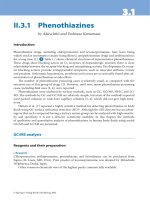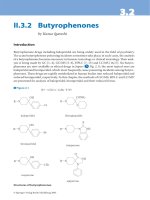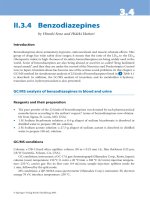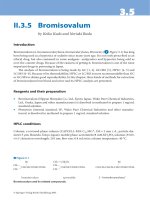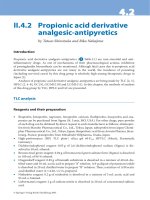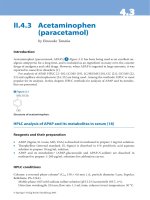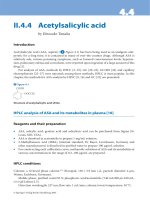Tài liệu Drugs and Poisons in Humans - A Handbook of Practical Analysis (Part 7) pptx
Bạn đang xem bản rút gọn của tài liệu. Xem và tải ngay bản đầy đủ của tài liệu tại đây (108.42 KB, 7 trang )
7
© Springer-Verlag Berlin Heidelberg 2005
I.7 Practical use of the
poison-net developed by the
Japan Information Network
(Hiroshima)
By Mikio Yashiki and Manami Nishida
Introduction
Forensic autopsy is an important task for proving crimes medically; unfortunately, every de-
partment of legal medicine of Japanese universities is su ering from insu cient sta s and
budget. About 30 years ago, one of the authors started the analysis of drugs and poisons at the
Department of Legal Medicine, Hiroshima University School of Medicine. At that time, the
author did not have much knowledge about poison analysis; but it is a good memory that many
good friends of toxicological societies gave the author many useful suggestions on analytical
methods. erefore, the author felt that nationwide non-governmental activities for communi-
cation about poisoning informations were essential among forensic (analytical) chemists, clin-
ical doctors and other people being involved in poisoning. e authors started creating a com-
munication network rst with letters, followed by telephone calls, facsimile, personal computer
communication and the mailing list using the Internet; according to the current of times, the
communication methods have changed and the number of registrants has increased in our
network. At the Department of Legal Medicine, Hiroshima University, a home page (HP) was
set up to enable the members to take a look into it subject to passwords. e HP includes the
contents of talks, which had been made for information exchange in the network, and many
other informations related to poisoning. In this chapter, the authors brie y present the practi-
cal use of the network.
What is “poison-net”?
e authors designated the activities of the Japan Poison Information Network as “poison-net”,
comprehensively. It includes “poisoning mailing list”, “analysis mailing list”, supply of informa-
tions of poisoning on Web, requests for analysis of a causative toxin, trials of toxin analysis and
hosting a short course of training for preliminary spot tests of drugs and poisons.
Poisoning mailing list (ml-poison)
e ml-poison () was started in about 1994, when the Internet
was introduced into Hiroshima University School of Medicine. e members of the poison-net
were composed of clinical doctors of emergency rooms, clinical technologists and experts of
52 Practical use of the poison-net developed by the Japan Information Network (Hiroshima)
toxicology; to protect human rights of patients, the press men and the general public were not
allowed to join the ml-poison. e good communication quality is being maintained to be able
to cope with the sudden outburst of a poisoning incident or accident; the complementary talks
are being refrained as possible. e mailing list is convenient for rapid response to an incident
or accident and for getting the newest informations, but caution should be taken against infor-
mations obtained through the mailing list, because they are occasionally not reliable. e
number of the registrants counted about 700 at the time point of August, 2001. A password is
given to each registrant to enable looking into the poisoning information part of HP of the
poison-net.
Analysis mailing list ( ml-anal)
In 1998, the Ministry of Health and Welfare of Japan distributed analytical instruments for
toxins to the 8 advanced critical care medical centers and the 65 critical care medical centers.
Each of the latter centers was equipped with an HPLC instrument and an X-ray uorescence
spectrometer, which costed twenty million yen; and the advanced critical care medical centers
were equipped with an HPLC, an X-ray uorescence spectrometer, GC/MS and other instru-
ments with the cost of eighty million yen. However, only with the introduction of such expen-
sive analytical instruments, they do not work in the absence of a su cient number of experts,
who can operate them. Many correspondences and questions about the instrumental analysis
were sent to our laboratory through the ml-poison. erefore, in 1999, the authors decided to
separately create ml-anal () to support toxin analysis in such criti-
cal care medical centers and other hospitals. e registrants of the ml-anal were composed of
the members of ml-poison who were interested in the analysis, engineers of manufacturers of
analytical instruments and attendees of the short course of the preliminary color tests; the
number of the registrants counted more than 300 in August, 2001. At the beginning, both ana-
lysts and engineers of manufactures got embarrassed saying, “Which kind of drugs or poisons
can be analyzed by HPLC?” and, “Which kind of drugs or poisons do the analysts want to ana-
lyze?”, respectively. Later, a er the instruments have become to work well, the qualities of the
questions became much higher.
Supply of information by the web
e URL of HP of the poison-net is ; this is expect-
ed to be changed in the near future according to servers to be used.
Storage of contents of talks made in the mailing lists
(ml-poison plus ml-anal)
e contents of talks made in both ml-poison and ml-anal were rearranged according to causa-
tive toxins, and shown in the “poisoning-talking salon” of HP of the poison-net (subject to a
password given to each registrant). e causative toxins are composed of daily necessaries, drugs
(including over- the-counter drugs), pesticides, natural toxins, industrial materials and others.
53
Many cases of poisoning and informations on analysis are shown in the HP. If talk contents
are opened to the public, the permission by each talker becomes necessary; the authors thus
refrain from introducing the contents in this chapter. However, the headlines of the “poison-
ing-talking salon” are being demonstrated in the top page of HP, which can be accessed without
any password.
Databases (DBs) in wide areas of poisoning
Various kinds of DBs related to poisoning are available in HP of the poison-net as shown
below.
i. DB for analytical methods
e papers describing analytical methods for drugs and poisons in human specimens were
searched by the Medline. e papers were selected by the eleven scientists, who were the
members of a joint study project supported by a Grant-in-Aid for Scienti c Research (B)
from the Ministry of Education, Science and Culture of Japan. Chemical compounds listed
were: natural toxins, organic solvent/toxic gases, anaesthetics (local anaesthetics, inhalation
anaesthetics, intravenous-injection anaesthetics and muscle relaxants), neuroleptics/anti-
depressants (psycho pharmaceuticals, antiepileptics and antiparkinsonian drugs), ampheta-
mines/narcotics, hypnotics/tranquilizers, pesticide and others. On the basis of extensive
informations collected from 900 papers, the most suitable analytical method can be rapidly
found by searching with a combination of a specimen name, an analytical method and a chem-
ical name (target) to be analyzed. Each specimen (urine, blood, authentics, serum/plasma,
tissues or others) and each method (TLC, HPLC, UV-VIS, GC/MS, GC, immunoassay,
MS, LC/MS or others) are chosen using the pulldown menu, and a chemical name (subject)
is input. When the search is made with a dubious name of a chemical, there is a possibility
not to be able to reach a corresponding analytical method; in this case, the chemical name
can be reexamined with a list of “chemical names stored in the DB of analytical methods”.
e analytical methods included in the DB are reliable, because the scientists who select-
ed them are experts of forensic toxicology. When any question on an analytical method is
sent to our Network by the ml-anal, a good answer will be returned by the responsible
scientist.
ii. DB for blood concentrations of causative toxins
In forensic cases in which drugs are involved, the assessment of blood drug concentration is
necessary. Also in clinical cases, the blood drug levels obtained by analysis should be rapidly
classi ed into therapeutic, toxic and fatal ones to serve for deciding the policy of treatment.
e blood levels and symptoms, reported by Mayer and by Winek both in 1994, and other data
in actual cases were input into the DB. e items for our input into the DB were: a name of a
drug, a name(s) of coexisting drug(s) (single, multiple and not clear), blood levels in the litera-
ture, institution number (forensic or analysis numbers), dead or alive, age, sex, interval a er
ingestion, outline of an incident, clinical or autopsy ndings, analytical method, levels of the
target drug obtained from blood and other specimens by analysis, unit of the values, the pres-
ence of other drugs in blood, cause of death/diagnosis, comments and address for correspond-
ence of a user. Care was taken for enabling an expert to directly correspond to the user about
Supply of information by the web
54 Practical use of the poison-net developed by the Japan Information Network (Hiroshima)
more details of an actual case. By comparing the analytical results with the data in the DB, it is
possible to estimate the antemortem conditions of a deceased and the symptom levels of a
living patient.
iii. DB for poisoning-related journals and toxicology society journals
e DB was mainly created by Prof. Shirakawa of Ehime University Hospital, Emergency Units,
and covers the contents of domestic journals and abstracts related to poisoning, which are not
included in international literature DB. When a user inputs a chemical for research together
with “OR” or “AND”, a list of journal name, society name, year, volume, page and title appears.
By clicking the title, the details of contents (abstract, authors and a liation) can be obtained.
Even in poisoning cases which had been only presented at a meeting and not been submitted
to a journal, good ideas for medical treatments may be included. When a poisoning incident
takes place with a chemical which is included in the DB, it may give useful informations on
treatments and analysis in the poisoning.
iv. DB for contents of talks in the ml-poison
e contents of talks in the ml-poison can be obtained by the method as described in section 1;
they are stored in a DB to make keyword research possible.
Other articles about poisoning appearing in HP of the poison-net
i. Simple color test methods for drugs and poisons (ver 2)
Screening or preliminary tests for drugs and poisons are essential before their instrumental
analysis to narrow probable compounds for poisoning. e article was abstracted from the
book [Department of Legal Medicine, Hiroshima University School of Medicine (ed) (2001)
Simple Detection Methods for Drugs and Poisons: e Color Tests. Jiho Inc., Tokyo]. It includes
cyanide compounds, carbon monoxide, organophosphorus pesticides, paraquat, bromisova-
lum, acetaminophen, barbiturates, tricyclic antidepressants, boric acid, amphetamines, screen-
ing methods using spot tests and some comments on analytical instruments.
ii. Manual for analysis of drugs and poisons (the first draft)
A manual for analysis of drugs and poisons was rst created on our Web site. “Manual for
Forensic Toxicology Analysis” was then published by the Forensic Toxicology Working Group
of the Japanese Society of Legal Medicine in a printed form, on the basis of this article (the rst
dra ) on the Web. e original dra on the Web contains more detailed description on toxin
analysis. It seems desirable to use both printed and Web ones for getting more detailed infor-
mations on analysis.
iii. Cautions in analysis of human specimens
In this article, pitfalls in analysis are being discussed. e contents are: the procedure of bio-
medical analysis, human specimens (sampling methods and cautions upon sampling and stor-
age), preliminary tests (cyanide compounds, arsenic compounds, azide, organophosphorus
pesticides, paraquat, glufosinate, controlled drugs, bromisovalum and acetaminophen), pre-
treatments of specimens (the methods and cautions), con rmatory analysis (analytical instru-
ments, methods and cautions), substantiation of drug standard collection and critical assess-
55
ment of analytical results. In every item, only basic problems are being discussed; but it is em-
phasized that the carelessness causes serious mistake.
Mediating service for the request of analysis of causative toxins
using the network
It is essential to analyze a causative toxin for making an e ective treatment. It is preferable to
analyze it at a local laboratory; however, unfortunately, institutions undertaking such analysis
are not many in Japan. Private clinical laboratory companies undertake analysis of the limited
number of toxic compounds. erefore, the authors established a system for receiving a request
of toxin analysis in the HP of the poison-net to respond to it at any time. When the request
form revealed in the HP is lled, it is automatically mailed to a manager who checks the con-
tents of the form; a er removal of undesirable parts of the contents, which may violate human
rights, it is mailed through the ml-poison to the members. When an analyst is found, direct
communication is made between the requester and the analyst. e analytical results are re-
ported to the ml-poison. If the requested analysis is regarded as a joint study between them, the
analysis is made free of charge for the requester; in principle, it should be presented at a meet-
ing or published in a journal. When no analyst is found, it is requested to a private clinical
laboratory company with a charge. In Japan, many experts are available for analysis of toxic
compounds; their results of analysis and maintenance of their analytical instruments are reli-
able. e above requesting system using the ml-poison can be regarded as a “virtual poison
control center” for analysis. In USA and Europe, many poison control centers dealing with
toxin analysis are present and well utilized; while, in Japan, the situation is much delayed and
no o cial institutions for toxin analysis are available at the present time. However, thanks
to the spread of activities of private express transportation companies, the cooled or frozen
specimens can reach any part of Japan within two days. With the intellectual and substantial
cooperation of the experts of toxin analysis distributed throughout Japan, similar activities
to those of poison control centers can be realized without an enormous cost using the
Internet and the above express transportation services. Until now, the authors experienced
many cases of analysis requests through the system. For example, in the cresol-poisoning inci-
dent which took place in Aomori, cresols in plasma and urine (free and conjugated forms with
glucuronide and sulfate) were repeatedly analyzed in Okinawa for specimens sampled from
patients at various intervals a er ingestion; the results were reported to the ml-poison one
week later. A part of list of the analysis requests is shown on the Web (.
hiroshima-u.ac.jp/analysis_2.html). As explained above, the mediating service through
ml-poison is useful for settlement of a poisoning incident. However, some problems should be
mentioned; it sometimes takes a long time for analysis, resulting in no contribution to clinical
treatments; when neither presentation at a meeting nor publication in a journal is realized a er
laborious analysis, the principle of being a joint study collapses, causing a trouble between the
analyst and requester on the cost. e authors feel that, even in a joint project, the cost for
analysis should be paid by a requester for continuation of the mediating service system for a
long time.
Mediating service for the request of analysis of causative toxins using the network
56 Practical use of the poison-net developed by the Japan Information Network (Hiroshima)
Trial for quality of analysis of drugs and poisons
Actual training of analysis is essential rather than collecting informations on analytical methods
to make accurate identi cation and quantitation of a causative toxin. Even with an identical
specimen, the discrepancies of analytical results can appear in di erent institutions, probably
due to di erent levels of skillfulness of analysts or di erent capability of instruments being
used; such discrepancies should be avoided by quality control. For this purpose, the authors are
hosting the trial for quality of analysis every year.
In the rst trial, a poisoning case was assumed in which a guest staying at a hotel did not
come out of his room for checkout; a bellboy discovered the guest collapsing and sent him to a
hospital. Together with paper describing ctitious situations and comments by a clinical doctor,
each serum specimen, to which a xed amount of pentobarbital had been added, was sent to
42 analysts who had wished the trial. e second trial (66 participants) was held on pecticide
poisoning with addition of an emulsion product of DCPA and NAC. For both trials, answers
were collected from the participants a er a while; about a half of them could achieve both
qualitative and quantitative analyses successfully, and a few could neither make qualitative nor
quantitative analysis for both trial. A er the collection, the model answers and the summaries
of the results given by all participants were returned to them. By examining the report, the self-
assessment of each participant could be made; it seemed useful for intensifying a sense of qual-
ity self-control. For correspondence and questions to the participants, the trial ML (ml-trial)
was used. In U.S.A. and Europe, such trials for analysis in poisoning are very common; while
no trials have been made in Japan except ours. Since the trials were made being supported by
a Grant-in-Aid from the Ministry of Health and Welfare of Japan, the participants were free of
charge. e authors are continuing the trials for improvement of analytical techniques of par-
ticipants. At the present time, however, they are being made without any nancial support; the
authors do hope that the national organization or o cial societies will undertake the quality
assurance of analysis of drugs and poisons.
Short course of training for simple preliminary tests
of drugs and poisons
As stated before, upon occurrence of a poisoning incident, preliminary tests are required to
narrow causative toxin candidates before accurate analysis by instruments of high performance.
Although the number of chemicals being analyzable by kits commercially available is limited,
it is very easy to handle them. Because of such easiness and simplicity, the authors hosted a
short course, in which clinical doctors were trained for simple poison analysis with the kits;
they will be able to analyze poisons at bedside by themselves before sending the specimens to
analytical experts. e short training course is being held under the auspices of the Committee
on Analysis of Japanese Society for Clinical Toxicology on the day before the Annual Meeting
of the Society. In the rst course, the participants were trained for tests of glufosinate in urine
(Basta qualitative kit), TLC for drugs (Toxi-Lab®), organophosphorus pesticides in urine, con-
trolled drugs by an immunoassay (Triage®), acetaminophen in serum and cyanide ion in blood;
the number of participants of this course held at Hiroshima University was 80. In the second
course held at Azabu University in the next year, the participants were trained for some of the
same tests as described above, but two tests were newly added, viz. tests for toxic gases and
57
boric acid in serum; but the participants counted 38 only. e cause of the decrease of partici-
pants might be due to that the tests were almost the same as those of the previous year and that
some participants wished instrumental analysis. In the next course, the authors are planning to
use some instruments.
Perspectives
e poison-net has been supporting people in the eld of clinical toxicology, especially in the
analysis of drugs and poisons using various methods described above. e authors do hope
that more lives su ering from poisoning will be saved with the assistance of the informations
obtained from the poison-net. e maintenance of this kind of system by a single institution is
too hard; it should be changed to be supported by a governmental organization or scienti c
societies. e network is based on the mutual trusting relationship of members; it does not
exist only for receiving informations, but does exist to supply reliable informations to members
positively. e latter will make the network more developed and upgraded.
It seems convenient for readers to take a look into HP and URL describing informations on
poisoning. However, the contents and URL will be changed during a long period of time. If the
readers can not access our network, please communicate to Hiroshima University Graduate
School of Medicine by other means.
Perspectives
